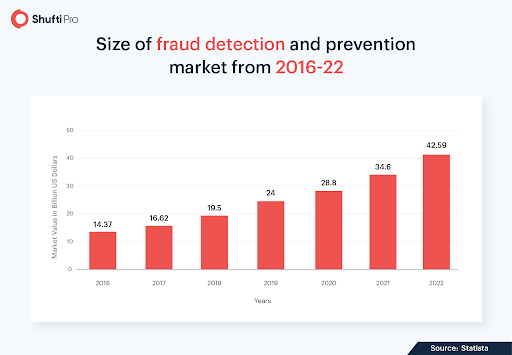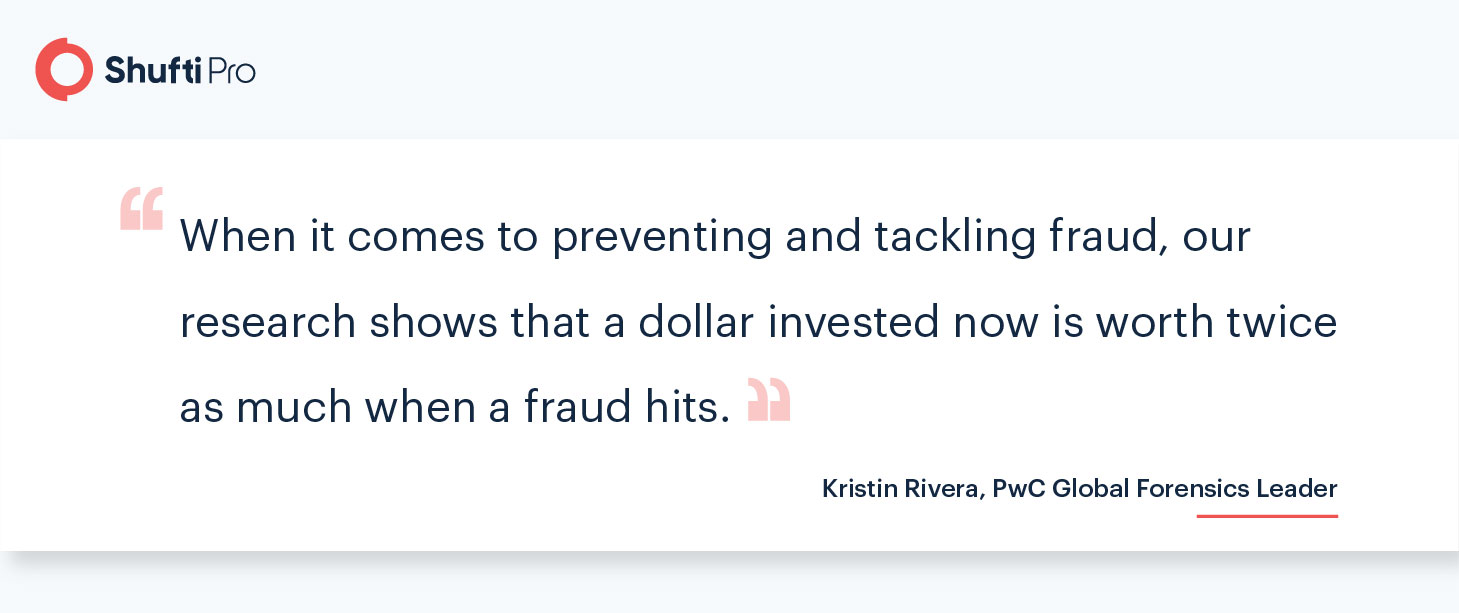10 Fraud Signals Every Industry Must Monitor

- 01 1- Fake or outdated Data
- 02 2- Suspicious Transactions
- 03 3- Customers from High-Risk Countries
- 04 4- Multiple Account of One Customer
- 05 5- Facial spoof attacks
- 06 6- Social Engineering
- 07 7- Card-not-Present
- 08 8- Replay Attacks
- 09 9- Invoices Under Approval Amount
- 10 10- No Previous Recorded Data
- 11 What Shufti Offers
Gone are the days when businesses paid attention to customer verification only. Today, organizations are moving into a more digital landscape and the trend of remote work is rising.his gives an advantage to fraudsters as digital spaces are prone to fraud attacks. According to The Guardian, in 2020 fraud cost £2.3 billion in the United Kingdom.
Businesses need to stay vigilant about the early signs of potential frauds and make appropriate efforts to eliminate them or minimize their impact. From financial and healthcare to travel and the real estate sector, every business is at the risk of fraud.Here are the ten fraud signals that every industry should monitor.
What are the common fraud signals that businesses overlook?
Having an idea of frauds before their occur gives an advantage to businesses in eliminating them, listed below are the fraud signals businesses should look out for:
- Fake Data
- Suspicious Transactions
- High-risk Customers
- Multiple Accounts
- Facial Spoof Attacks
- Social Engineering
- Card-Not-Present
- Replay Attack
- Under Invoicing
- No Previous Record
1- Fake or outdated Data
Giving false or outdated data to a business is an easy task for fraudsters. While onboarding new customers, businesses take their data to keep a record, but at this step, fraudulent players tend to submit their fake data, which is an early sign of fraud. Such customers are more likely to commit financial frauds later, although giving fake data is itself a fraud. For instance, a customer can give their false address while checking out from an e-commerce store and then claim false chargeback for not receiving the order.

In this case, the fraudster ends up buying the products without paying, while the e-commerce store itself is highly affected by the chargeback fraud. According to Payments Dive, frauds in the e-commerce industry are expected to surpass USD 20 billion by 2021.
2- Suspicious Transactions
Monitoring customer transactions and reporting suspicious transactions is mandatory for financial institutions, Here are the red flags for suspicious transactions:
- Payments over a specific value
- Cross-border transactions surpassing a certain limit
- Unusual amount or timing of deposits and withdrawals or any other financial activity
The Bank Secrecy Act of FinCEN requires financial institutions in the US to file a Suspicious Activity Report (SAR) to regulators for doubtful transactions exceeding USD 10,000. This is a major sign of money laundering, where a person may be working as a money mule for an Ultimate Beneficial Owner (UBO).
3- Customers from High-Risk Countries
High-risk countries are those which are categorized by international financial watchdogs like Financial Action Task Force, to have a high rate of corruption, recurring money laundering issues, and a weak regulatory compliance framework. Customers from these countries try to open accounts in international financial institutions with the intention of laundering money, while the sources of their funds are not legal. Dealing with these customers can also lead to penalties or sanctions by regulatory authorities.
4- Multiple Account of One Customer
This scam occurs when one customer creates multiple accounts on one platform, be it e-commerce platform, gaming site or online bank. Scammers give the same data to a platform using different IPs or tweak some parts of the data to make it seem legitimate. Here’s how criminals use multiple accounts to their advantage:
- E-commerce industry faces misuse of promo codes or discount coupons
- In social media platforms, these are used for spamming or reaching a wider audience
- Through multiple bank accounts, criminal can launder their money
- Fraudsters use numerous accounts in gaming to manipulate the winning results

5- Facial spoof attacks
Seeing is not believing, well in the online space this fits the best. This is because the person you communicate with on social media might not exist in real life, or their photo may be synthetic. For those who don’t know what facial spoofing is, it is a method in which a cybercriminal disguises themselves as someone else by using a photo, video, a face mask, or some fraudulent material.
Spoof attacks have increased in recent years and are mostly used for creating online bank accounts or applying for loans. It can potentially lead to identity theft, account takeovers, money laundering, and other financial crimes.
Most of the facial spoof attacks are done through 2D or 3D objects to deceive facial recognition solutions. In 2D masks, fraudsters use a photograph or flat paper, while in a 3D mask, they use a sculpture or 3D print. These masks are also created using robots or 3D printers which are more accurate and dynamic, creating multiple masks at a time.
Deepfake is another example of a spoof attack where AI technology is used to create realistic videos of the victim.
6- Social Engineering
In social engineering, fraudsters manipulate people into giving their account credentials and other sensitive information. The most common example is a phishing scam where emails are sent claiming to be from a government authority demanding credit card or bank account password. In August 2021, a warning was issued by the Federal Trade Commission about the SMS phishing attacks where scammers impersonate state agencies.
Through a brute force attack or gaining account credentials through phishing, bad actors carry out another type of fraud called account takeover. The hijacked account is later used for buying online goods, illegal transfer of funds or claiming discounts.
7- Card-not-Present
The fraud in which a perpetrator uses stolen information of a cardholder (name, billing address and CSV Code) to purchase something over an online platform or telephone where the card is not presented to the merchant.
8- Replay Attacks
The form of digital fraud in which the data transmission is delayed, replayed or repeated between a customer-business interaction is known as replay attack. Through this, the scammer steals sensitive information of the customer and business.
9- Invoices Under Approval Amount
This fraud is committed by the employees of an organization who have the idea of a dollar threshold and then create a bill just below that. For instance, if your organization approval level is USD 10,000, and you receive a receipt for USD 9,800.
10- No Previous Recorded Data
During onboarding new employees remotely, if a candidate has no previous record with any other organization or educational institute, it is a trigger that this is potentially synthetic data having no link with an authentic person.
What Shufti Offers
Shufti offers Know Your Customer services, in which each user’s data is verified by authenticating their identity documents in real-time. The AI-powered solution helps business ensure secure and smooth onboarding of customers, keeping intact with global regulatory requirements, Shufti’s multi-tier identity verification solution secures online accounts from potential digital fraud.
Want to know more about how Shufti helps in preventing frauds?











